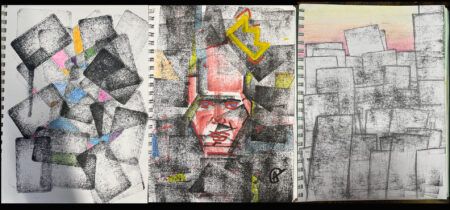Amy Jackson joined Art21 Educators in 2021. She has been teaching art for 25 years in public and independent middle and upper schools. Since 2004, North Cross School, an independent college preparatory school in Roanoke, Virginia, has been her school home in various teaching and administrative capacities, but the art studio is her happy place. She is passionate about exploring, noticing, connecting, and reflecting as core components of making (and life!). As a perpetual learner who still wonders what she will be when she grows up, she gratefully credits Art21, and especially Art21Educators, with fostering her ongoing search.
Teaching with Contemporary Art
What’s Your Artistic Practice?
How Art21, Curating, and Jorge Lucero Made Me Feel Like an Artist Again

Courtesy of Amy Jackson.
What’s your artistic practice? I cringe at the inevitable question that floats around whenever art teachers get together. Is it because I’m surprised? (Wait…I’m supposed to have two jobs?!) Is it from guilt or embarrassment? (I do have an honors degree in painting that I have barely directly used…) Shame? (Dare I admit I have never felt the pull to be a practicing artist?)
Before I am completely dismissed as artistically incompetent, know that I relish being immersed in art–viewing, discussing, exploring, teaching, connecting. I feel creative neurons pinging in my brain while interacting with art and helping students manifest their ideas. I also love creating, but I have always been intimidated by a perceived pressure to be profound. I suppose my most frequent excuse for not having a separate personal art practice is that with a job and family, all my time, energy, and creativity depletes before I can make anything of my own.
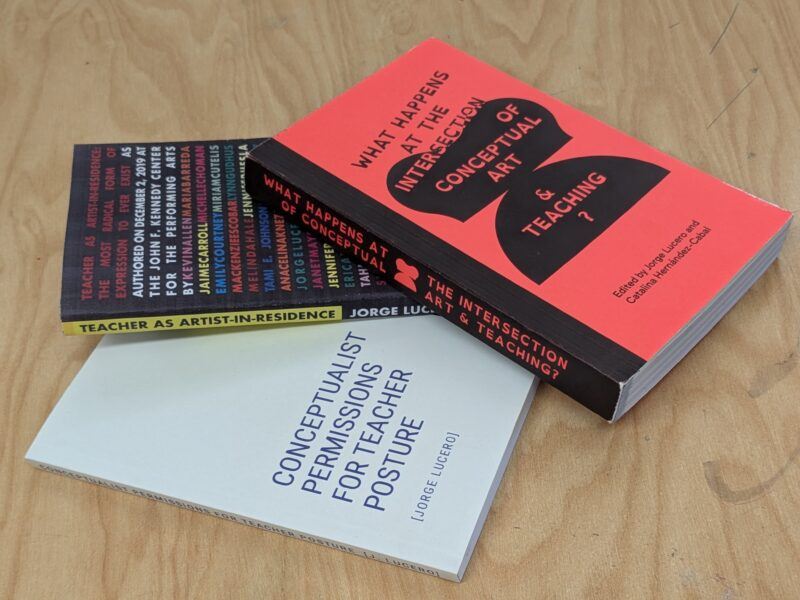
Courtesy of Amy Jackson.
Enter Dr. Jorge Lucero, Full Professor of Art Education in the School of Art + Design and Associate Dean for Research in the College of Fine and Applied Arts at the University of Illinois Urbana-Champaign. I first learned about Lucero’s work from two other Art21 Educators, Sonia D’Agnese and Jess Perry-Martin. Additionally, an Art21 Educators book club explored Lucero’s collaboration Teacher as Artist-in-Residence: The Most Radical Form of Expression to Ever Exist. Lucero is both a teacher and artist who writes and speaks about how he integrates the two practices. He talks about the challenge of doing both simultaneously and how he develops ways to “test the pliability” of his spaces and making within his given time and locations. He asks questions like: How can readily accessible materials become a practice, like folding magazine pages to alter the meaning of both images and the new combined image? How can rearranging bulletin board displays in the halls become art? How can one find “permission” in other artists’ work to do or not to do a given thing?
Around the same time, I was finding renewed creative fulfillment in my classroom work through designing student exhibits in our school’s gallery spaces. I had already started thinking about how developing these displays felt like making. Could these acts of curating be an extension of my students’ work? Does this count as my making art? How can students and I collaborate? Lucero’s work, practice, and teaching deeply resonated with me as I pondered these questions. I wondered how I could “test the pliability” of my own constraints, with “permission” from Lucero.
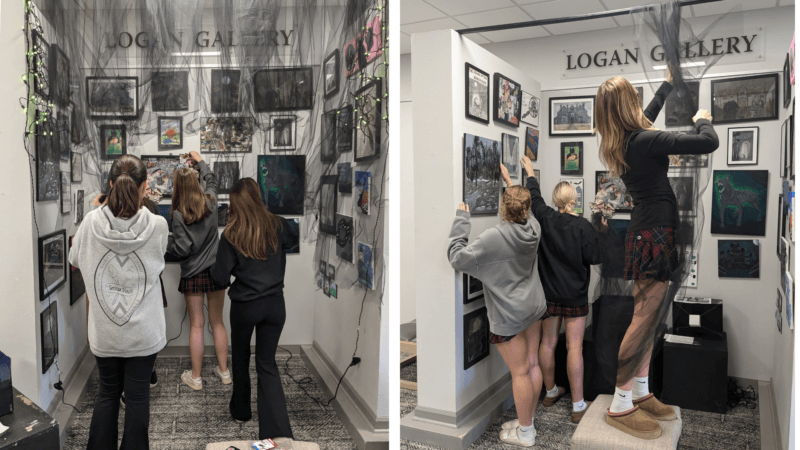
Courtesy of Amy Jackson.
How, too, could I encourage students to consider the display of their art as part of their process? For one project, they arranged a crochet coral reef exhibit I had initially designed, and then they rearranged it again and again for new spaces. For another exhibit, I was interested in creating a studio wall to highlight the many types of work they had created. The students ran with that plan, as well, deciding to arrange nearly 100 pieces by color like a rainbow on the wall. They researched studio walls and discovered they were “invented” in pre-revolution France as a way for everyone to enjoy art, not just the aristocracy. The students felt this expressed the process in our studio perfectly, and I agreed. My ideas for “curating as making” shifted to them in a beautiful way.
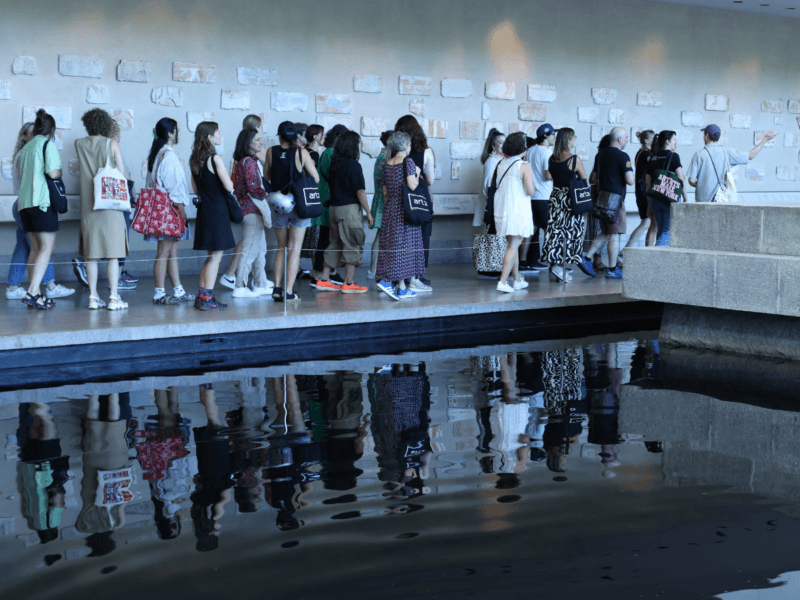
Art21 Educators at The Met wih Adam Milner.
A few months later, I had the opportunity to go to The Metropolitan Museum of Art with Art21 artist Adam Milner as our guide during the 2024 Art21 Educators Summer Institute. As he does in his 2021 Art21 New York Close Up film, “Adam Milner Takes Care of the Details,” Milner let us view ancient artwork through his eyes, especially as he paid careful attention to the way the objects are displayed. He challenged us to stretch our concept of what constitutes the art by asking us also to notice the brackets and pedestals that support the pieces. Those props are often deliberately formed and painted to blend in, which blurs the lines of where the artwork begins and ends—and also acknowledges makers behind the scenes. In his own work, Milner gives some of his sculptures temporary exhibit locations beyond museum walls, such as one in a bodega and another in a friend’s car. Milner’s considerations of blurred lines in making and location remind me of Lucero’s “testing pliability” and finding “permissions” from various sources. Milner gives another example for my students and me to extend our own thoughts about art and making, and it feels distinctly contemporary both in art and pedagogy.
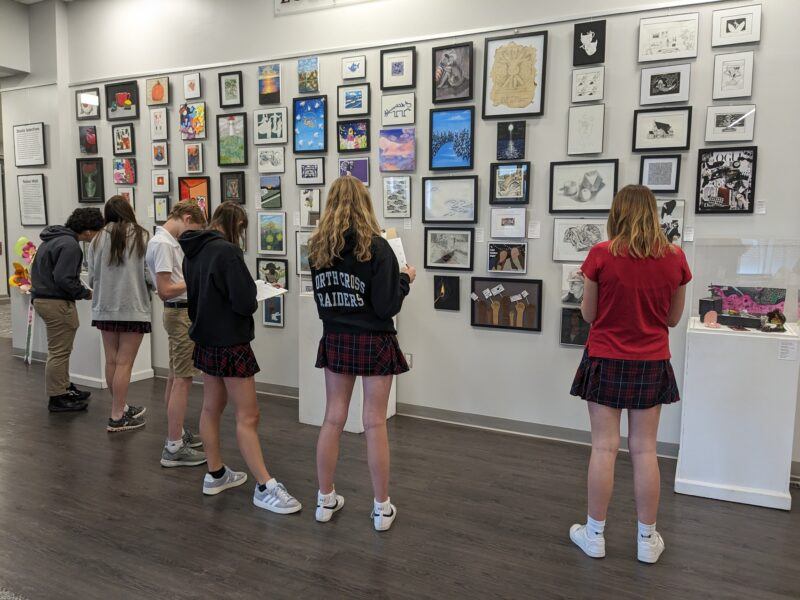
Courtesy of Amy Jackson.
Ultimately, all of these resources were made available to me through the Art21 Educators Program. These colleagues from all over the world regularly share great artists and ideas that most definitely encourage me to test the pliability of what I thought possible for my students and myself. Art21, the act of curating, and Jorge Lucero, gave me permission to be an artist again. There is likely no solo show in my future, but I am now making, even if not prolifically. I’m especially taken with printmaking, curating, and big scale collaborative work, things I never studied formally. Actually, if I follow Lucero’s logic and stretch my definition of making, I have been an artist for years. With this reframing, I feel more artistically productive and content than I have in a long time. Mostly, though, I am having so much fun. For that, thank you, Art21. Thank you, Art21 Educators. Thank you, Jorge Lucero. Thank you, Adam Milner. Thank you, students. I am forever grateful.



